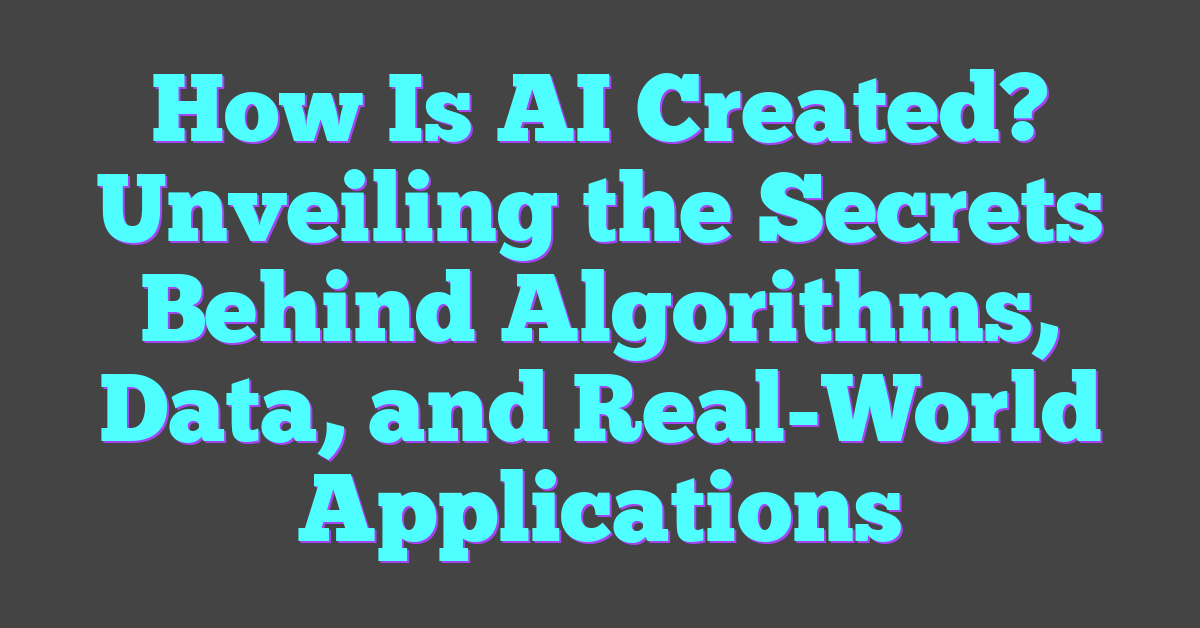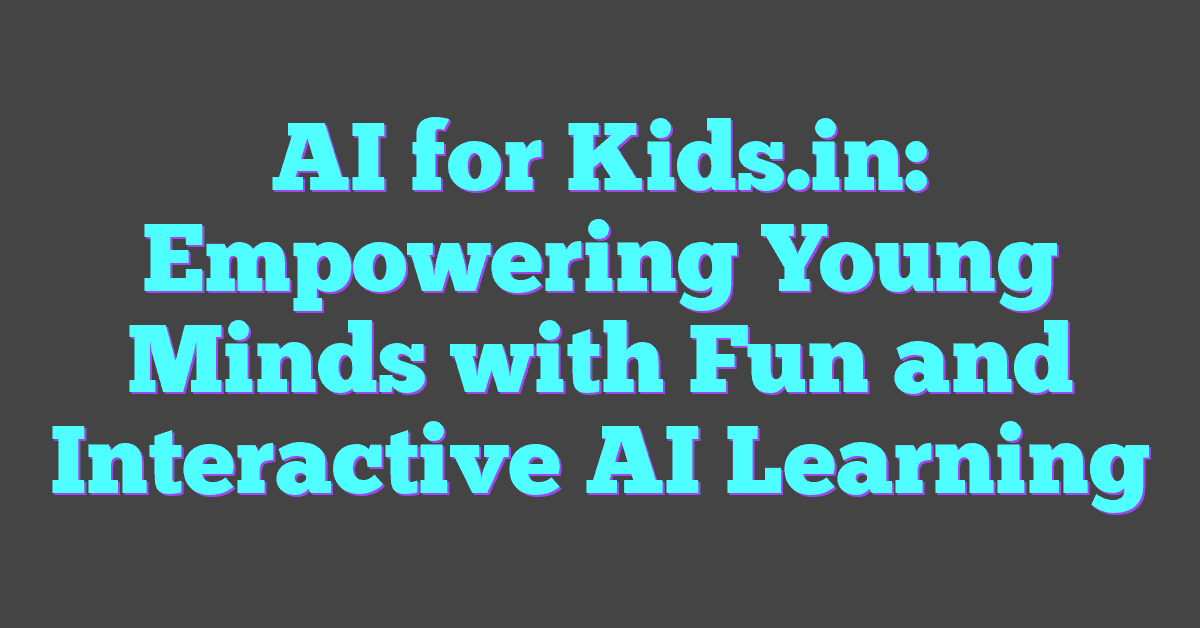Artificial Intelligence, or AI, has quickly become a buzzword in today’s tech-driven world, but how exactly is it created? Behind the scenes, a fascinating blend of algorithms, data, and computing power come together to bring AI to life. From self-driving cars to virtual assistants, AI’s applications are as diverse as they are groundbreaking.
Understanding the Basics of AI Creation
Understanding the creation of AI requires grasping fundamental concepts and methodologies integral to the field.
What Is AI?
Artificial Intelligence, or AI, refers to systems or machines that mimic human intelligence to perform tasks. These tasks encompass a range of activities, from learning and problem-solving to visual perception and language processing. AI systems leverage algorithms and data to make decisions and predictions. For instance, AI algorithms drive self-driving cars, enable smart home devices, and power advanced customer service chatbots.

Key Concepts in AI Development
AI development revolves around several core concepts that enable machines to acquire and apply intelligence.
Algorithms
Algorithms form the backbone of AI, providing step-by-step instructions for data processing and decision-making. Common algorithms include neural networks, decision trees, and clustering algorithms. Neural networks, modeled after the human brain, are crucial for deep learning applications.
Data
Data serves as the fuel for AI models. High-quality, well-labeled datasets are essential for training algorithms. Big data, encompassing vast amounts of diverse information, significantly enhances AI capabilities. Examples include image datasets for computer vision and text corpora for natural language processing.
Machine Learning (ML)
Machine Learning, a subset of AI, focuses on the development of systems that can learn from and adapt to data. Supervised learning, unsupervised learning, and reinforcement learning are primary ML techniques. Supervised learning uses labeled data to train models, while unsupervised learning identifies patterns in unlabeled data. Reinforcement learning involves decision-making agents improving through trial and error.
Computing Power
Advanced computing power accelerates AI development. High-performance GPUs (Graphics Processing Units) and TPUs (Tensor Processing Units) enable the efficient processing of large datasets and complex algorithms. These hardware advancements shorten training times and increase model accuracy.
Ethics and Bias
Ethics in AI ensures that AI systems operate fairly and without discrimination. Addressing bias in data and algorithms is crucial to avoid prejudiced outcomes. Ethical AI development includes transparent practices and accountability. Guidelines from organizations like the IEEE provide frameworks for ethical AI usage.
These components—algorithms, data, machine learning, computing power, and ethical considerations—collectively drive AI creation. Understanding them is foundational for anyone exploring the dynamic field of artificial intelligence.
The Role of Data in AI Creation
Data acts as the cornerstone for AI creation. It enables systems to learn, adapt, and improve, which is essential for achieving accurate and efficient AI solutions.
Data Collection
Data collection involves gathering relevant datasets for training AI models. These datasets can span multiple domains such as text, images, and audio. Reliable sources include publicly available databases, proprietary datasets, web scraping, and sensor data. Efficient collection methods ensure the quality and relevance of data used in training models.
Data Processing
Data processing cleans and transforms raw data into a format suitable for training. It encompasses data cleaning, normalization, and augmentation. Data cleaning removes errors and inconsistencies, while normalization ensures uniform data scaling. Data augmentation increases the dataset size by creating variations of existing data, enhancing model robustness. Effective processing enhances the AI’s learning capabilities.
Algorithms and AI Models
AI blends algorithms and models to create intelligent systems.
Designing Algorithms
Designing algorithms involves crafting specific steps for problem-solving. Developers first define the task and desired outcome. Then they select the most suitable algorithm type, such as supervised, unsupervised, or reinforcement learning. For instance, supervised learning algorithms (e.g., regression, classification) use labeled data, while unsupervised learning algorithms (e.g., clustering, association) explore unlabeled data patterns.
In supervised learning, the system learns from input-output pairs. Unsupervised learning finds hidden structures in data. Reinforcement learning optimizes actions through rewards and penalties, as seen in gaming AI.
Training Models
Training models involves feeding algorithms with data to learn patterns. The process starts with a training dataset, consisting of many examples. The model adjusts parameters to minimize errors through techniques like backpropagation and gradient descent. For instance, neural networks fine-tune weights after each iteration.
Iteration involves cycles through the training data, improving accuracy. Validation datasets help adjust hyperparameters and avoid overfitting. Developers use techniques like cross-validation to ensure models generalize well to unseen data.
Algorithms and models are foundational to AI. Creating effective AI requires designing robust algorithms and meticulously training models with high-quality data. Each stage, from task definition to optimization, plays a crucial role in developing intelligent systems.
Testing and Refining AI Systems
Testing and refining AI systems are crucial steps in developing effective and reliable AI solutions. These processes ensure the system performs as expected and adapts to new data and tasks.
Evaluation Techniques
Evaluation techniques assess the performance of AI systems by measuring their effectiveness. Methods such as cross-validation, which divides data into subsets to test and train the model, help in evaluating accuracy. Confusion matrices highlight true positive, true negative, false positive, and false negative rates. Precision, recall, and F1 score metrics reveal the balance between correct classifications and missed instances. Benchmark datasets enable consistent comparison across models and approaches. Leading sources like Kaggle and UCI Machine Learning Repository offer diverse datasets for rigorous testing.
Iterative Improvement
Iterative improvement is a continuous process of refining AI models to enhance their performance. Using techniques like hyperparameter tuning, developers adjust model parameters to find optimal settings. Feedback loops enable models to learn from their mistakes by continuously incorporating new data. Ensemble methods, combining multiple models, increase robustness and accuracy. Regular updates ensure the AI system remains effective against evolving challenges. Techniques such as online learning and incremental training help maintain the system’s adaptability to changing environments.
Real-World Applications of AI
Artificial Intelligence (AI) is no longer confined to research labs. It has penetrated various industries, transforming the way tasks are performed and decisions are made.
Healthcare
AI has made significant strides in healthcare. It aids in diagnosis through image recognition, analyzing medical images like X-rays and MRIs to detect anomalies. AI-powered predictive analytics help identify potential outbreaks and patient risks by analyzing trends in patient data. Natural Language Processing (NLP) enables processing clinical notes and extracting useful information for better patient care. Virtual health assistants, powered by AI, provide round-the-clock support, answering patient queries and offering medical advice. Companies like IBM Watson and Google Health lead advancements in AI healthcare applications.
Automotive Industry
The automotive industry leverages AI to revolutionize driving. Autonomous vehicles use Machine Learning (ML) models and sensor data to navigate and make real-time decisions. AI enhances safety features like collision avoidance, adapting to road conditions and driving behaviors. Predictive maintenance systems utilize AI to forecast vehicle part failures, reducing downtime and maintenance costs. AI also powers in-car virtual assistants, improving user experience by controlling navigation, infotainment, and climate settings through voice commands. Tesla and Waymo are at the forefront of integrating AI into automotive technology.
AI continues to reshape various sectors, driving innovation and improving efficiencies.
Conclusion
AI’s journey from concept to real-world application is truly fascinating. By combining algorithms, data, and computing power, developers create systems that are transforming industries and improving lives. Whether it’s through enhancing healthcare diagnostics or driving the future of autonomous vehicles, AI’s potential seems limitless. As technology advances, AI will continue to open new doors and bring innovative solutions to the forefront. It’s an exciting time to witness how AI is shaping our world and driving progress in ways we never imagined.
Frequently Asked Questions
What is Artificial Intelligence (AI)?
Artificial Intelligence (AI) refers to the simulation of human intelligence in machines that are designed to think and act like humans. It includes components such as algorithms, Machine Learning techniques, and the necessary computing power to operate efficiently.
How is data important in AI development?
Data is crucial in AI development as it helps train algorithms and models to recognize patterns, make decisions, and improve over time. Data collection and processing techniques are vital for creating accurate and efficient AI systems.
What are the ethical considerations in AI?
Ethical considerations in AI include ensuring fairness, transparency, and accountability in AI systems, addressing biases in data, and ensuring the security and privacy of individuals’ information.
What are some real-world applications of AI in healthcare?
In healthcare, AI is used for diagnosis, predictive analytics, and virtual health assistants. Companies like IBM Watson and Google Health are utilizing AI to improve patient care, streamline operations, and enhance medical research.
How is AI transforming the automotive industry?
AI is transforming the automotive industry through advancements in autonomous vehicles, enhanced safety features, and predictive maintenance systems. Companies like Tesla and Waymo are leading the way in integrating AI into their automotive technologies.
Who are some of the leading companies in AI innovation?
Leading companies in AI innovation include IBM Watson, Google Health, Tesla, and Waymo. These companies are at the forefront of integrating AI into various sectors to drive innovation and efficiency.
What is the role of algorithms in AI?
Algorithms are the core components of AI that enable machines to process data, recognize patterns, and make decisions. They are essential for the development and functioning of intelligent AI systems.
Can AI operate without computing power?
No, AI requires substantial computing power to process large volumes of data, train complex models, and execute tasks efficiently. Computing power is fundamental to the development and performance of AI technologies.




